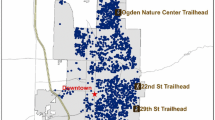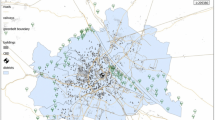Abstract
This paper examines the impacts of a multi-purpose trail on residential property values in a hedonic model. Using a large housing data set in combination with street network distances, we show that proximity to trail entrances positively effects property values. Among other things, our study compares the hedonic model results from three different spatial specifications. We pay specific attention to the direct and indirect effects on residential property prices associated with potential changes in house characteristics. In addition, our study predicts property values around trail entrances using a ‘modified spatial predictive process’ approach that is well suited for capturing spatial dependence in large data sets.


Similar content being viewed by others
Notes
‘Friends’ help out scenic Little Miami trail: Loveland—For supporters of the Little Miami Scenic Trail, their charge borders on a sacred trust, Cincinnati Enquirer August 21 2010. The 2 days of count were Wednesday, July 28 and Sunday, August 8 2010.
Estimation results available on requests.
Not to be confused with the assessed value used for property tax calculations which, in Ohio, is simply defined as 35 % of the true market value.
Markov Chain Monte Carlo estimation results are based on a simulated chain where the first 5,000 samples are discarded as a ‘burn-in’ period, followed by 15,000 iterations that were collected to produce posterior summaries for the parameters of interest.
Since the spacing of the locations is relatively irregular, we could use a space-covering design (see Royle and Nychka 1998). To overcome this issue, we implement a larger numbers of knots making sure that results are robust to the selection of knots.
References
Anderson ST, West SE (2006) Open space, residential property values, and spatial context. Reg Sci Urban Econ 36(6):773–789
Asabere P, Huffman F (2009) The relative impacts of trails and greenbelts on home prices. J Real Estate Finance Econ 38(4):408–419
Banerjee S, Gelfand AE, Finley AO, Sang H (2008) Gaussian predictive process models for large spatial datasets. J R Stat Soc Ser 70:825–848
Berry BJL, Bednarz RS (1975) A hedonic model of prices and assessments for singlefamily homes: does the assessor follow the market or the market follow the assessor? Land Econ 51(1):21–40
Brasington David M (1999) Which measures of school quality does the housing market value? J Real Estate Res 18:395–414
Cheshire P, Sheppard S (1995) On the prices of land and the value of amenities. Economica 62(246):247–267
Clapp JM, Nanda A, Ross SL (2008) Which school attributes matter? The influence of school district performance and demographic composition on property values. J Urban Econ 63(2):451–466
Cotteleer G, van Kooten GC (2012) Expert opinion versus actual transaction evidence in the valuation of non-market amenities. Econ Model 29(1):32–40
Cressie N (1993) Statistics for spatial data. John Wiley and Sons, New York
Finley AO, Sang H, Banerjee S, Gelfand AE (2009) Improving the performance of predictive process modeling for large datasets. Comput Stat Data Anal 53:2873–2884
Gelfand AE, Ecker MD, Knight JR, Sirmans CF (2004) The dynamics of location in home price. J Real Estate Finance Econ 29:149–166
Hess DB, Almeida TM (2007) Impact of proximity to light rail rapid transit on station-area property values in Buffalo, New York. Urban Stud 44(5):1041–1068
Kiel K, Zabel J (2001) Estimating the economic benefits of cleaning up Superfund sites: the case of Woburn, Massachusetts. J Real Estate Finance Econ 22(2–3):163–184
Krizek K (2006) Two approaches to valuing some of bicycle facilities’ presumed benefits: propose a session for the 2007 National Planning Conference in the City of Brotherly Love. J Am Plan Assoc 72(3): 309–320
Lancaster KJ (1966) A new approach to consumer theory. J Polit Econ 74(2):132–157
LeSage JP, Pace RK (2004) Models for spatially dependent missing data. J Real Estate Finance Econ 29(2):233–254
LeSage J, Pace RK (2009) An introduction to spatial econometrics. Chapman Hall/CRC Press, London
Lindsey G, Man J, Payton S, Dickson K (2004) Property values, recreation values, and urban greenways. J of Park Recreat Adm 22(3):69–90
Lynch AK, Rasmussen DW (2001) Measuring the impact of crime on house prices. Appl Econ 33(15):1981–1989
Mogush P, Krizek KJ, Levinson D (2005) The value of trail access on home purchases. Presented at 84th annual meeting of transportation research board in Washington, DC, 9–13 Jan 2005
Nicholls S, Crompton JL (2005) The impact of greenways on property values: evidence from Austin, Texas. J Leis Res 37(3):321–341
Nicholls S, Crompton JL (2007) The impact of a golf course on residential property values. J Sport Manag 21(4):555–570
Rosen S (1974) Hedonic prices and implicit markets: product differentiation in pure competition. J Polit Econ 82(1):34–55
Royle JA, Nychka D (1998) An algorithm for the construction of spatial coverage designs with implementation in SPLUS. Comput Geosci 24:479–488
Spiegelhalter DJ, Best NG, Carlin BP, van der Linde A (2002) Bayesian measures of model complexity and fit. J R Stat Soc Ser B 64:1–34
Valente J, Wu SS, Gelfand A, Sirmans CF (2005) Apartment rent prediction using spatial modeling. J Real Estate Res 27:105–136
Ventolo WL, Williams MR (1994) Fundamentals of real estate appraisal. Real Estate Education Company, Chicago, IL
Acknowledgments
We would like to thank the University of Cincinnati for support of this research through an University Research Council (URC) Interdisciplinary Grant. We want to thank also David Brasington for providing us with data about school districts and tax rates, Thomas Wuerzer and Kat Haessler for their support with the ArcGis network analysis, and Andrea Yang for all of her editorial work.
Author information
Authors and Affiliations
Corresponding author
Rights and permissions
About this article
Cite this article
Parent, O., vom Hofe, R. Understanding the impact of trails on residential property values in the presence of spatial dependence. Ann Reg Sci 51, 355–375 (2013). https://doi.org/10.1007/s00168-012-0543-z
Received:
Accepted:
Published:
Issue Date:
DOI: https://doi.org/10.1007/s00168-012-0543-z




